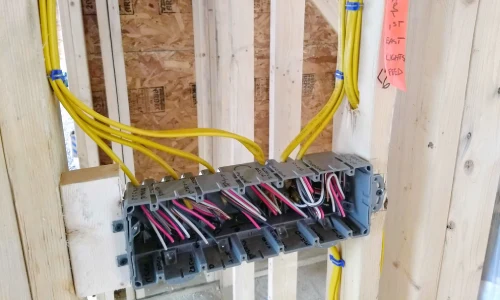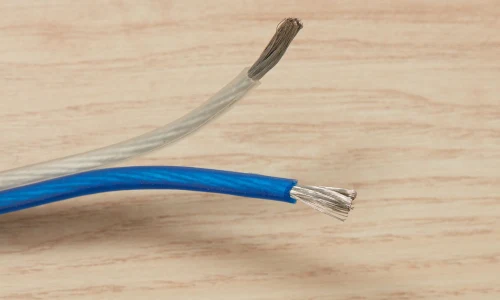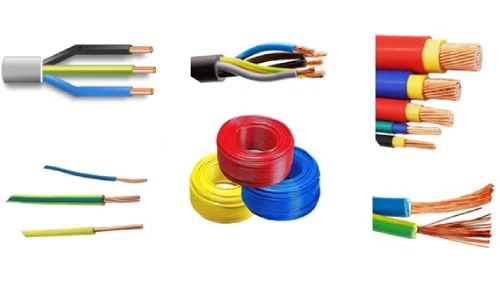Types of building wiring
In this article from Bond Electric, one of the best electrical services in Canada, we will examine the types of building wiring and we will also talk about the types of electrical wires suitable for wiring buildings and homes.
Building wiring refers to the electrical system that supplies the building with electricity. It is a starting point for all electrical appliances and systems and is an essential part of any home or business.
Building wiring systems are designed to carry electricity from the power company’s transformer station through the walls, ceilings, and floors of the structure and finally reach the outlet where it is delivered to the device or lighting fixtures.

There are two main types of building wiring: ducted and non-ducted.
Conduit is used when wiring is installed in a concrete floor or wall cavity, while non-conduit wiring refers to wiring that is installed in walls or ceilings without any conduit.
In addition to the two main categories of building wiring, there are three other types: branch circuits, feeders, and switchboards. These types of construction wires are different based on their use and application in the electrical system of the structure.
Introduction of building wiring types
The main function of building wiring is to protect residents from electrical hazards such as fire and electrocution.
The building wiring system consists of conductors and circuit protection devices. Conductors include cables and wires that are used to transmit current and voltage to equipment inside buildings.
Circuit protection equipment includes fuses and circuit breakers that are used to interrupt current flow in the event of an overload or short circuit condition. Buildings have their own unique characteristics that affect the selection of building wiring materials.

Some of the important factors that affect the design of building wiring are:
- Building location (urban or rural).
- Type of building (residential, commercial or industrial).
It can be said that types of building wiring are electrical wiring that is used to supply electricity to buildings, houses and other structures. The types of construction wires used depend on the voltage and current required for the application.
Types of building wiring
There are different types of construction wires:
Copper
As one of the types of building wiring, copper is a popular choice for most residential buildings because it offers good conductivity, high durability, and relatively low cost. However, when exposed to certain chemicals and environments, it can corrode, which can lead to short circuits and other problems.

Aluminium
Aluminum is similar to copper in many ways, but it has several key advantages that make it ideal for some applications. It is more resistant to corrosion than copper, so it is often used in saltwater environments where corrosion is a problem with copper.
It also has a lower resistance than copper, meaning it can carry more current without overheating or requiring larger conductors than conductors made from other materials.
While aluminum is not as conductive as copper, compared to other options such as steel wire or cable, it is still very effective at carrying power over long distances with minimal loss due to resistance (although there will still be some loss). This makes it a good option.
There are many types of electrical wiring that can be used in the home and building, from simple Romex to more advanced types such as CL3 and CL2. Each type has its own uses and requirements, and it’s important to know how each one works before you start working with it.

Here is an overview of the most common types of residential wiring:
NM cable (non-metallic)
This is a common cable used in many residential installations. It has a flexible jacket and a rubber or plastic sheath around the wires inside.
NM cable can be installed in conduit but cannot be installed in direct buried applications.
Romex (Romex®)
This is a generic term that refers to NM cable and non-metallic sheathed cable (NMSC). Romex is commonly used in new construction, remodeling projects, and personal home improvement jobs because it is inexpensive and easy to work with.
There are different types depending on the number of conductors inside each insulated wire jacket – 0.4, 0.2, 0.1 and others – as well as whether there are aluminum or copper conductors inside those jackets.
What is the best wire for house wiring?
In the continuation of examining the issue of types of building wiring, we would like to explain the best type of wires for electrical wiring in the house.
Bare copper or ROMEX is the most common type of wire used in homes. It comes in various sizes and measurements (thickness) and is inexpensive. The downside is that it is difficult to peel and fold.
If you’re looking for a more durable option, consider Aluminum Clad Steel Cable (ACS). It is more expensive than bare copper, but has better resistance to corrosion and wear.

Like Romex, it comes in different sizes (gauges) and you should use the right one for whatever application you have in mind. In the US, most homes have Romex or THHN wire.
There are many different types of wire that you may need to use for your electrical projects. Here are some common wires to be aware of:
- 2/14 – This is the most common type of home wiring in the United States. It is a 14 gauge wire with two conductors and has a maximum current of 15 amps. It is usually used as an electrical cord or lamp cord, but it can also be used for other things such as some appliances or window air conditioners.
- 12/3 – This is another popular wire for home wiring. It is 12 gauge with three conductors, so it can handle up to 40 amps (although this may not be recommended). It is usually used for larger appliances such as gas stoves or heaters that require more power than 2.14 wattage.
- 10/2 – This is similar to 14/2, but has two conductors instead of three. The maximum current is 15 amps, the same as the 2.14, so it can be used for many applications that do not require a lot of electricity, such as lamps or small appliances such as coffee makers or blenders.
- 8/3 – This is another common type of household wire, especially in older homes.
Introduction of wire types and sizes
As mentioned, electrical wires in buildings are used for both power transmission and data transmission. They are made of copper or aluminum and come in different sizes, types, and insulation materials used in the building for wiring.
There are two main types of power cord: stranded and solid.
Stranded wire is made of several strands of smaller solid wire twisted together. This type of wiring is better for use in high voltage applications because it can conduct electricity more efficiently than solid wire. Solid wiring is commonly used in low voltage applications such as household appliances.
The size of an electrical wire is determined by its gauge, that is, how many times the diameter of the solid core wire is placed in its outer diameter. For example, if you have an 8 gauge, the core must be 8 times its outer diameter before it touches itself.

The smaller the gauge number, the larger the wire. So, larger gauges generally mean that higher voltages can be passed through them without overheating or burning out due to excessive current (10 gauge vs. 16 gauge, for example).
The size of an electrical cable also affects its resistance and ability to transfer heat. This means that smaller cables heat up faster than larger cables, but they also cool down faster.
When it comes to electrical wiring, the most important thing is the safety of your home and building. You can’t compromise on quality when it comes to wiring. If you are planning to upgrade your electrical system and want to know what sizes and types of wires are available in the market, this article will help you.
We hope that by reading this article, you have obtained useful information about the types of building electrical wiring and also by introducing suitable wires for wiring in the building and home.
For more information as well as the installation of various types of lights, building electrical wiring in Canada, upgrading electrical panels, …. you can contact the experienced experts of Bond Electric in Canada.
